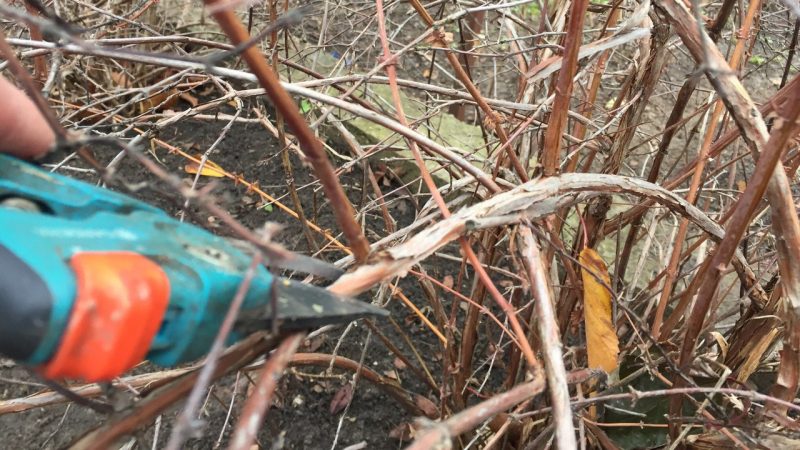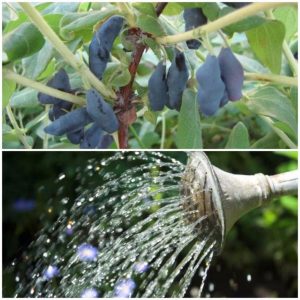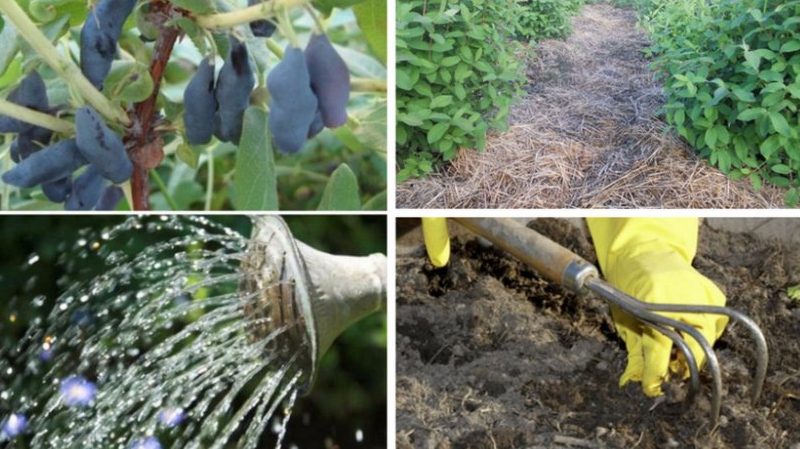Honeysuckle care steps in autumn to prepare for winter
In the fall, it is important to properly care for the honeysuckle to get large, fragrant berries for the next year. Shrubs of edible and decorative honeysuckle are not afraid of frost and are resistant to low temperatures, but they also have their own subtleties of preparing for winter.
The content of the article
How to care for honeysuckle in autumn
Honeysuckle care in the fall and preparation for winter include standard agricultural practices:
- watering;
- pruning;
- top dressing;
- shelter;
- transplant and reproduction as needed.

What does the plant need during this period
After picking berries, plants have an increased need for nitrogen, phosphorus and potassium, organic substances. The plant must accumulate strength to resist cold weather. Complex mineral or organic fertilizers are applied to the soil at short intervals.
Reference! Nitrogen fertilizing is not used in autumn.
Autumn activities
Prepare honeysuckle to winter they begin in September or the last decade of August. Specific measures depend on the age of the bush, the number of branches, and soil composition.
Pruning

Rejuvenating pruning is carried out in adult shrubs at the age of 6-8 years, sanitary pruning - annually. Broken and dry branches are removed without affecting young shoots, since berries are formed on the shoots of the current year.
To rejuvenate the bush, thick old branches are cut out, leaving a small stump above the ground. On each bush, 4-6 old shoots are left, which are cut off in the next 2-3 years.
Important! Old branches are removed first in the center of the bush, leaving an empty space in it for air to enter.
Top dressing
In order for honeysuckle to bear fruit well next year, minerals and organics are introduced into the soil at the end of summer and autumn:
- potassium salt, potassium sulfate or monophosphate;
- superphosphate;
- nitroammofosku - no later than the first decade of September;
- wood ash solution;
- compost.
Fertilizers are added either in combined mixtures, or alternate between them.
Bone or fish meal mixed with wood ash (2: 1) is used as an organic source of phosphorus and potassium for shrubs.
The soil next to and under the honeysuckle is sown with siderates. These plants, thanks to their developed root system, bring deep-lying nutrients to the surface, and when they rot, they release a large amount of organic matter. Some green manure contains phytoncides that repel pests.
Suitable for planting under shrubs:
- clover;
- lupine;
- white mustard;
- Vika;
- oats;
- peas.
In August, the plants are cut to the root and embedded in the soil for active decomposition.
Watering

In the absence of rain and in the heat, the bushes are watered at least 1 time per week. 1.5 buckets of water are consumed per bush, 2.5 buckets in drought. The same regime is observed in dry autumn.
Regular hydration prevents honeysuckle from going into winter dormancy ahead of time.
Treatment
The soil is processed depending on the type of soil guidance. When mulching, they do not resort to loosening, only replacing the mulch layer from time to time.
If the soil is open, it is dug up - but this is done with caution, since the roots of the plant are superficial. If there are siderates, they are cut off with a hoe and buried in the ground without removing the roots.
Protection against diseases and pests
To protect shrubs from the spring outbreak of diseases and pests, the soil around is treated with fungicides.
For prophylaxis, all fallen leaves, trimmings are removed from under the bushes and from nearby territories, since they serve as a wintering place for bacteria and fungi.
Important! Places of cut branches must be treated with garden varnish or oil paint: a cut is an open wound for a plant, into which small pests and pathogens easily fall.
How to prepare for winter
The plant is characterized by increased resistance to frost, therefore it does not require special protection from cold weather. From rodents, the bushes are covered with a synthetic bag or net.
Shelter, insulation
Although honeysuckle is a resilient plant, some gardeners in the northern regions are reinsured, especially if the snowy and cold winter is coming. Young shrubs are protected by spruce branches in the form of a hut. They also cover the soil with straw, sawdust, agrofibre.
Care depending on the age of the plant
There are no fundamental differences in the care of young and adult honeysuckle bushes. The main difference is pruning. In young plants, shoots are removed in the center, providing air flow to the branches.
For adult bushes, such pruning tactics are poorly applicable: they only remove curved shoots, strongly inclined extreme and inward branches.
Depending on the region of cultivation
In the middle lane there are no harsh winters, therefore, they cover only decorative varieties that are not frost-resistant.
In the Urals insulate varieties with low resistance to frost or during cold winters with little snow. Additionally, snow is poured under the bushes to reduce the risk of plant death.
In Siberia winters are often heavy rainfall, which puts you at risk of breaking branches from snow. Experienced gardeners tie the bushes into one bunch and cover it with a fine mesh so that the buds do not gnaw at the birds.
Depending on the variety
The care of edible honeysuckle is almost independent of the variety. At the same time, decorative forms of culture with red inedible berries - honeysuckle - are sometimes grown in gardens. Such plants are less resistant to cold weather, they are sheltered in all regions.
Honeysuckle is cut in a different way than edible honeysuckle: in the fall, only 5-6 main branches are left, removing all the rest. Lateral shoots are cut by 1/3 to stimulate their growth and active branching. Sanitary pruning involves removing broken off, dried out shoots and branches showing signs of disease.
Experienced gardening tips

For better wintering and fruiting in the next season, some recommendations are followed:
- pruning is best done in autumn, since in spring honeysuckle wakes up early - there is a risk of damaging it by cutting off the awakened branches;
- to protect against rodents, bait with poison is laid out under the plants;
- honeysuckle is a moisture-loving plant, but it is undesirable to swamp the soil under it;
- tall varieties are covered for the winter so that the birds do not damage the shoots;
- it is a forest plant that prefers a soil with a characteristic litter - mulching is recommended to ensure good wintering and harvest.
It is interesting:
The best ways to keep honeysuckle fresh and processed for the winter.
How can you freeze honeysuckle for the winter in the form of juice, puree or whole berries.
Conclusion
Autumn care for honeysuckle is not a big deal, even for novice gardeners. Agrotechnical measures are standard: plants are watered, fertilized, pruned, covered for the winter, protected from diseases and pests. This crop is cold tolerant by itself, but extra care will only improve the quality of the next season.